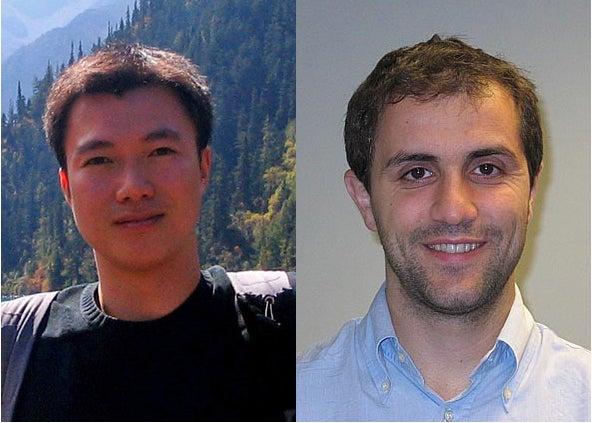SLAC Scientists Win Prestigious DOE Early Career Research Awards
Two SLAC physicists and an LCLS researcher from Berkeley Lab have won prestigious Early Career Research Awards from the Department of Energy’s Office of Science.
By SLAC Communications
Two SLAC physicists and an LCLS researcher from Berkeley Lab have won prestigious Early Career Research Awards from the Department of Energy’s Office of Science. They are among 68 young researchers selected from a nationwide pool of 850 applicants.
The award winners are:
- Dao Xiang, a SLAC accelerator physicist who is working on a technique known as “external seeding” for improving the function of X-ray free electron lasers.
- Leonardo Senatore, a theoretical physicist with the SLAC-Stanford Kavli Institute for Particle Astrophysics and Cosmology (KIPAC) who is applying particle physics techniques to answer questions in cosmology.
- Oliver Gessner, a Berkeley Lab physicist who is using LCLS, the Linac Coherent Light Source, to study the fundamental physics of a promising method for increasing the efficiency of solar cells.
The five-year grants, announced Tuesday by the DOE Office of Science, are designed to provide financial support to exceptional young researchers at a point in their careers when they may be long on ideas but short on research funds.
“These awards demonstrate the extraordinary breadth of the research going on at SLAC – from theory to cutting-edge experiments and the development of accelerator technology that will power the research of tomorrow,” said SLAC Director Persis Drell. “I offer my congratulations to these young scientists and their colleagues across the nation.”
Improving X-ray laser performance
Xiang, a staff scientist with the Accelerator Research Division, said he believes SLAC's earlier successes in using an external laser to tune the properties of an electron beam played a role in winning his $2.5 million award. He will use the funding to continue his research at the lab’s Next Linear Collider Test Accelerator.
Xiang is working on developing a more advanced version of this “external seeding” technique, as well as better ways to manipulate and diagnose the qualities of the electron beams that are used to generate X-rays for free-electron lasers, or FELs. These improvements can lead to breakthroughs in the performance of next-generation X-ray FELs.
External seeding involves using a laser beam from outside the accelerator to tune the qualities of electron bunches in a beam. These techniques give the beam “a more pure, more narrow spectrum; we have more control of the radiation,” Xiang said. The seeded electron beam could deliver ultra-narrow bandwidth X-ray pulses with a wavelength of about one nanometer, useful for a wide range of experiments.
Xiang said he will also use the research award to pursue techniques for measuring ultra-short electron bunches in free-electron lasers. Possible beneficiaries include SLAC's planned LCLS-II and the proposed Next Generation Light Source project at Lawrence Berkeley National Laboratory.
Tor Raubenheimer, principal investigator of the Echo-7 program who has worked with Xiang on that project, said, "Dao is a fantastic scientist and will do great work with this award."
Developing new tools for cosmology
Senatore, a theoretical physicist with KIPAC, received a $750,000 award for his proposal to use techniques that have proven highly successful in particle physics – the study of the quantum realm – to develop tools for probing the birth and development of our universe.
Until recently, he said, the limitations of telescopes and other instruments restricted the quality of cosmological data gathered by observation and experiment. But those data now are “very, very good. They are so good that theory is lagging behind experiment,” Senatore said. He hopes to catch cosmological theory up to experiment with the same methods particle physicists use to cope with the data from particle accelerators.
Effective field theories are developed by simplifying a problem in a way that tries to explain only the data most relevant to it. Newtonian mechanics, which describes the way the universe behaves when all objects are travelling much slower than the speed of light, can be thought of as an example.
Guided by effective field theory, Senatore wants to develop new analytical techniques for studying phenomena such as cosmological inflation, the period after the big bang when the primordial universe supposedly underwent a vast expansion that stretched and flattened the fabric of space-time. Inflation explains many aspects of our current universe, but as yet cosmologists can't explain inflation.
"I am so pleased that Leonardo's work, marrying the calculational tools of theoretical physics to the impressive advances in observational cosmology, is being recognized in this way," said KIPAC Director Roger Blandford.
Understanding solar cells
Berkeley Lab’s Gessner was a member of the third team of researchers to do experiments at the LCLS. In a 2010 paper, they described using its intense X-ray laser pulses to strip some of the inner electrons away from molecules of nitrogen gas, creating “hollow atoms.”
In another round of experiments last year, Gessner and his colleagues used the LCLS to study the way electrons flow in semiconductors coated with dye molecules.
Scientists are trying to create a new type of cheap, efficient solar cell by coating semiconductors with dye molecules that absorb a broad range of solar wavelengths. The excited dye molecules transfer charge to the semiconductor, the first important step in creating electrical current from sunlight.
However, after about two decades of research, the efficiencies of these cells are still significantly below those of other technologies. Gessner’s LCLS experiments aim to help break this impasse by getting a deeper understanding of what’s happening at the interface between the dye and the semiconductor. His $2.5 million award will help support the continuation of this and other work related to molecular electronics.
“Our study won’t improve the efficiency of these cells by tomorrow or next year,” Gessner said. “But if you manage to really understand, on the molecular level, how the electrons march through these systems, then you may have a better chance of improving the systems based on predictive knowledge.” Although the data from last year’s experiments are still being analyzed, he said, the results so far look promising.

(Photos courtesy Xiang and Senatore)

(Photo courtesy Oliver Gessner)